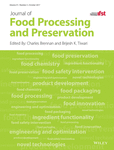Extraction of Aril Oil from Gac (Momordica cochinchinensis Spreng) Using Supercritical Carbon Dioxide
Abstract
The objectives of this research were to determine the suitable conditions and mathematical equations to predict the efficiency of aril oil extraction from gac (Momordica cochinchinensis Spreng), including the amounts of β-carotene, lycopene, iodine value, acidity, and peroxide in the oil, using supercritical carbon dioxide. The experiments were planned using central composite design (CCD) for two factors, temperature (31, 35, 45, 55, and 60C) and pressure (130, 150, 200, 250, and 271 bar), and the optimal conditions for oil extraction were 50–60C and 200–250 bar, which resulted in 80–100% extraction efficiency, 30–50 mg β-carotene per 100 g, 10–20 mg lycopene per 100 g of oil, 60–80% iodine values, and an acidity of 0–4 mg potassium hydroxide. In comparing the oil extraction efficiency and the amounts of β-carotene, lycopene, iodine value, and acidity, there was a discrepancy (%D) of <10% between the experimental values and the values predicted from a mathematical model at 55C and 220 bar, indicating that the mathematical model was able to predict the extraction efficiency and the amounts of β-carotene, lycopene, iodine value, and acidity very well. Moreover, when the pressure was increased, the extraction efficiency also increased, and when the temperature was increased at a pressure of 150–200 bar, the extraction efficiency decreased. These increases in temperature and pressure resulted in greater amounts of β-carotene and lycopene in the aril oil from Momordica cochinchinensis Spreng.
Practical Applications
The extraction of aril oil from Momordica cochinchinensis Spreng using supercritical fluid was studied. The optimal conditions for the extraction of aril oil from Momordica cochinchinensis Spreng using a supercritical fluid were 52–55C and 200–250 bar, which resulted in an extraction efficiency of 80–100%, 30–50 mg β-carotene per 100 g, 10–20 mg lycopene per 100 g, 60–80% iodine values, and an acidity of 0–4 mg potassium hydroxide per gram. Supercritical fluid extraction resulted in a better extraction efficiency of oil with higher amounts and better chemical properties of carotenoids compared to using a screw press.




